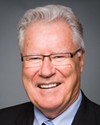Merci, monsieur le président. Committee members, thank you for the opportunity to discuss the high-level mandatory capabilities for Canada's next-generation fighter aircraft.
You recently had the opportunity to hear from Mr. Dan Ross, our Assistant Deputy Minister (Materiel), concerning the process being used to procure the F-35 as the best price, best capability and, thus, best-value fighter for Canadians under the MOU signed by the Joint Strike Fighter Program partners. I will therefore focus specifically on Canada's requirements—and the extensive analysis of options—for the fighter we will use for the next 30 to 40 years.
As I noted previously before this committee, manned fighters are essential to our ability to maintain control and sovereignty over our airspace, whether in Canada or during operations abroad. Neither unmanned aerial vehicles nor any other air platform can carry out this demanding and complex task, whether they are operating in air-to-air or air-to-ground roles. This is the same conclusion reached by many of Canada's allies.
Following the announcement of the government's intent to acquire a next-generation fighter in the Canada First defence strategy, we examined our requirements very closely and finalized them in early 2010. We looked at future and current roles and missions that our next-generation fighter would be responsible for and the environment—both physical and threat—in which it would be operating.
We need a capability that helps us carry out our core missions of defending the sovereignty of Canadian and North American air space through NORAD, providing Canada with an effective and modern capability for international operations, and effectively conducting joint operations with our allies through NATO or a coalition.
We need robust aircraft, capable of operating across Canada's vast geography and under harsh and varying weather conditions and deterring challenges to Canadian sovereignty.
Because we cannot afford to acquire and operate multiple, specialized fighter fleets, tomorrow's fighter aircraft must be capable of undertaking a variety of air-to-air and air-to-surface combat roles. In a more generic sense, the fighter must be capable of undertaking whatever defence role we demand of it, whether that is a northern sovereignty patrol, an intercept role, war-fighting, surveillance, or anything else.
Furthermore, to be prepared for the future, the aircraft must be flexible enough to deal with threats and missions that were unexpected at the time of its conception. We know that some of the threats faced by the CF-18 in the late 20th century have faded, some have continued, and new ones have emerged. There is no reason for us to doubt that we will continue to see similar fluidity and evolution in threats as this century unfolds. We assume that technology will continue to evolve on various fronts, such as data processing, threat detection, weapons systems, self-defence suites, and interoperability, to give just a few examples.
Specifically, our short list of high-level mandatory capabilities, which are qualitative and not quantitative in nature, comprise the following characteristics.
Range: the aircraft must have the range to be capable of deploying in NORAD and NATO alert configurations, in accordance with instrument flying rules without air-to-air refuelling support, whether the aircraft is flying non-stop from a main operating base to a deployed operating base or from a main operating base to a forward operating location with one stop en route if required.
Endurance:
The aircraft must have the endurance to be capable of operating from a main operating base, a deployed operating base or a forward operating location in accordance with instrument flying rules and maintain a combat air patrol in accordance with Canadian Forces, NORAD and NATO requirements.
Speed: our next fighter must have the speed to be capable of successfully conducting an intercept of air-breathing threats—that is to say, non-ballistic threats such as fighters or bombers—to Canadian airspace or to airspace assigned to the Canadian Forces in accordance with NORAD and NATO standards.
Air-to-air refueling: The fighter must be capable of receiving fuel in flight to extend its range and endurance.
Deployability: our next fighter must be capable of deploying to and operating from forward operating locations domestically and worldwide in a full range of geographic, environmental, climatic, and threat conditions.
Intelligence, surveillance, and reconnaissance: the fighter must be capable of providing non-traditional intelligence, surveillance, and reconnaissance data before, during, and following the deployment of weapons. This capability will assist targeting, intelligence, and command entities in a variety of decision-making processes.
Weapons: the aircraft must precisely deliver a range of air-to-air and air-to-surface weapons in all weather conditions, day and night, and in permissive and non-permissive environments to provide a spectrum of tailored weapons effects.
Survivability:
The aircraft must be capable of defending itself by employing a range of self-defence technologies and minimizing the risk of detection, engagement and damage in predicted threat environments.
Growth potential: the aircraft must be capable of continuous upgrade to its level of interoperability, survivability, and operational capabilities for the duration of its lifetime.
Fleet size: the fleet must be large enough to conduct assigned missions and roles while simultaneously maintaining combat-ready force generation capability—that is, training new crews and maintenance of aircraft.
Certification:
The aircraft must be capable of certification and sustainment in accordance with Canadian standards.
Delivery: the delivery times must give us the capability of achieving an initial operating capability of the new aircraft, coordinated with the CF-18 Hornet's end of lifetime. In other words, the new fighter must begin delivery in 2016 to allow overlap with the Hornet's projected retirement in 2020, and thus avoid a gap in our defence capabilities by ensuring that such needs as trained crews are ready to go. In procurement terms, that is almost tomorrow.
The analysis of the quantitative mandatory requirements associated with these high-level mandatory capabilities for Canada's next fighter made it clear that only a fifth generation fighter could satisfy our mission needs in the increasingly complex future security environment.
The F-35 Lightning II is the only aircraft that meets our mandatory requirements and the only fifth-generation aircraft available to Canada. The fifth-generation F-22 Raptor is an excellent air superiority fighter that is being upgraded through the addition of selected capabilities that have found their origins in the F-35. However, the United States government does not permit foreign sales. Russia has a fifth generation under development, and China is expected to do the same.
Three key capabilities distinguish a fifth-generation fighter from a fourth-generation fighter.
First, interoperability—a unique combination of stealth, long-range high-resolution sensors and security high-capacity networks that allow aircraft to communicate with one another and share data in a secure environment.
Secondly, sensors and data fusion: a system that consolidates tactical information from the sensors and off-board sources to provide pilots with a clear understanding of the tactical situation at a glance.
Thirdly, survivability: that is very low observable stealth, advanced sensors, a comprehensive self-defence suite, and secure data link that mean a fifth-generation aircraft can accomplish more in a mission with fewer supporting assets.
It is important to be clear that a fourth-generation aircraft cannot be upgraded to a fifth-generation aircraft. You cannot turn a fourth-generation CF-18, even a modernized version such as ours, into a fifth-generation stealth aircraft.
The F-35 Lightning II represents the revolutionary difference from previous generations of fighters in terms of capabilities, and it brings unique advantages. It brings stealth technology. Low observability will significantly reduce the aircraft's electromagnetic signature and therefore reduce detection by enemy sensor systems. It provides lower risk and improves survivability for the pilot, as well as enhanced intelligence, surveillance, and reconnaissance capabilities, all of which have significant relevance across the Government of Canada's defence priorities of national, continental, and international operations. It possesses advanced sensor and data fusion technology that will gather, synthesize, and display information to help pilots understand the tactical situation at a glance, make complex tactical decisions quickly, and take decisive action. The aircraft takes care of much of the data gathering and synthesis that pilots now have to do themselves and that has become almost overwhelming in its quantity and speed. In effect, the aircraft is the co-pilot.
We will have interoperability with our partners and allies that will be seamless, safe and effective within NORAD and NATO and on coalition operations.
The F-35 allows us to share its entire situational awareness with partner aircraft. When we go into operations abroad with like-minded coalition nations with the same platform, the aircraft are the same. Therefore, we can share resources and quickly go into an operation without weeks of training, because we have the same kit and software as our partners. It makes a big difference in how we're going to do business as a coalition.
Furthermore, the aircraft is sustainable. We will be able to replace lost aircraft, or acquire additional aircraft if the future global situation demands it, because the production line will operate until at least 2035. Software will be upgraded on an ongoing basis, and we will not have to contract individually for upgrades, bringing huge savings and keeping the aircraft up to date as technology evolves.
In conclusion, given the increasingly complex and uncertain future security environment, the F-35 Lightning II will provide Canada with the greatest probability of mission success and the greatest probability that our men and women will survive and return safely from their missions.
We are acquiring the F-35 Lightning II to protect Canadian interests and to counter tomorrow's threats. Procured and sustained through the JSF program, the F-35 is the best value for our taxpayer dollar and will keep Canada at the forefront of fighter operations, enabling our fleet to remain relevant, flexible, viable, and sustainable well into the middle of this century.
The F-35 Lightning II is not an unnecessary luxury. It is the right tool, at the best value, to properly do the job that Canada and Canadians want their air force to carry out on their behalf.
Thank you, ladies and gentlemen. I would be happy to address any questions you have about the high level mandatory capabilities for our fighter.
Thank you very much.











